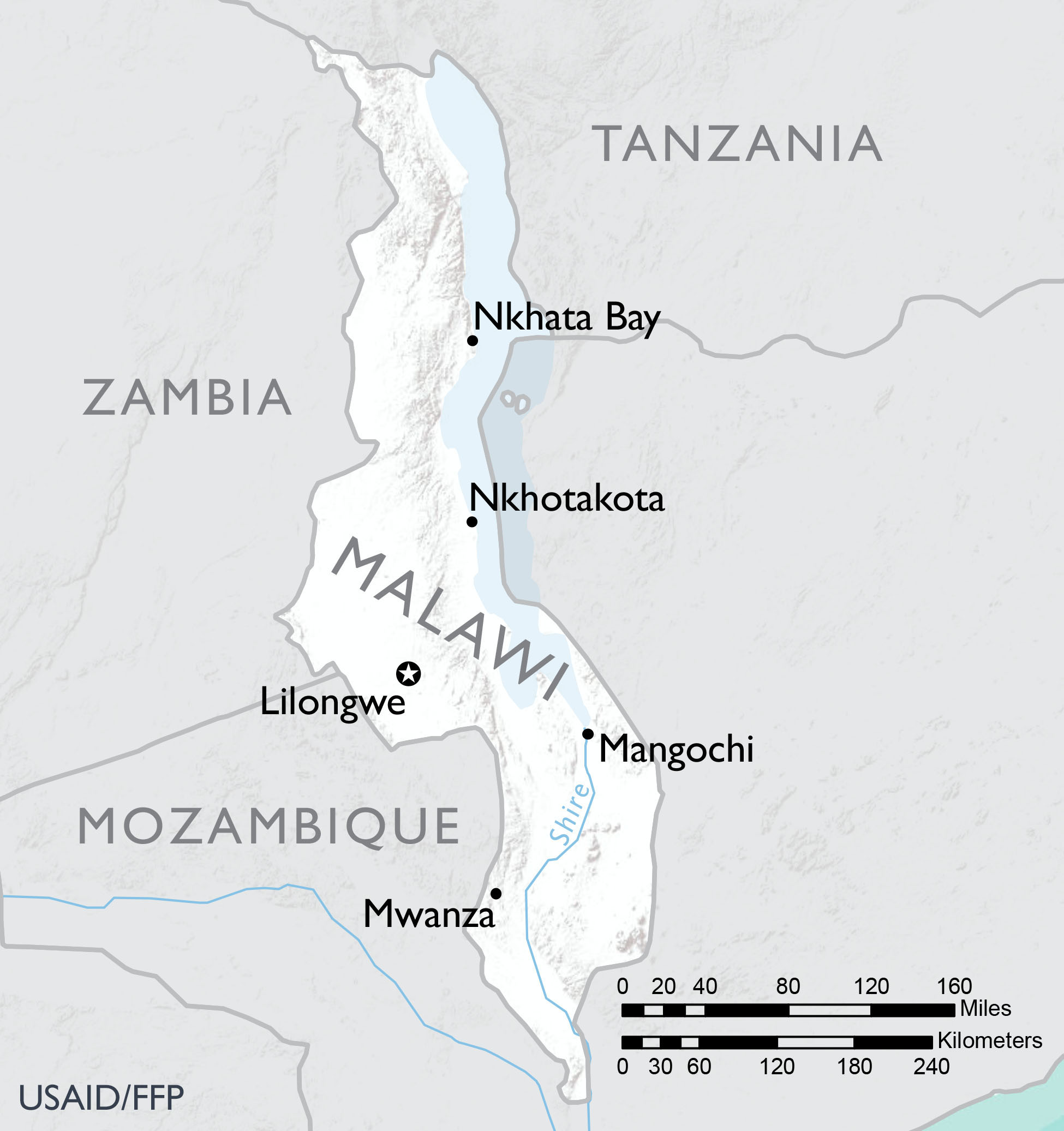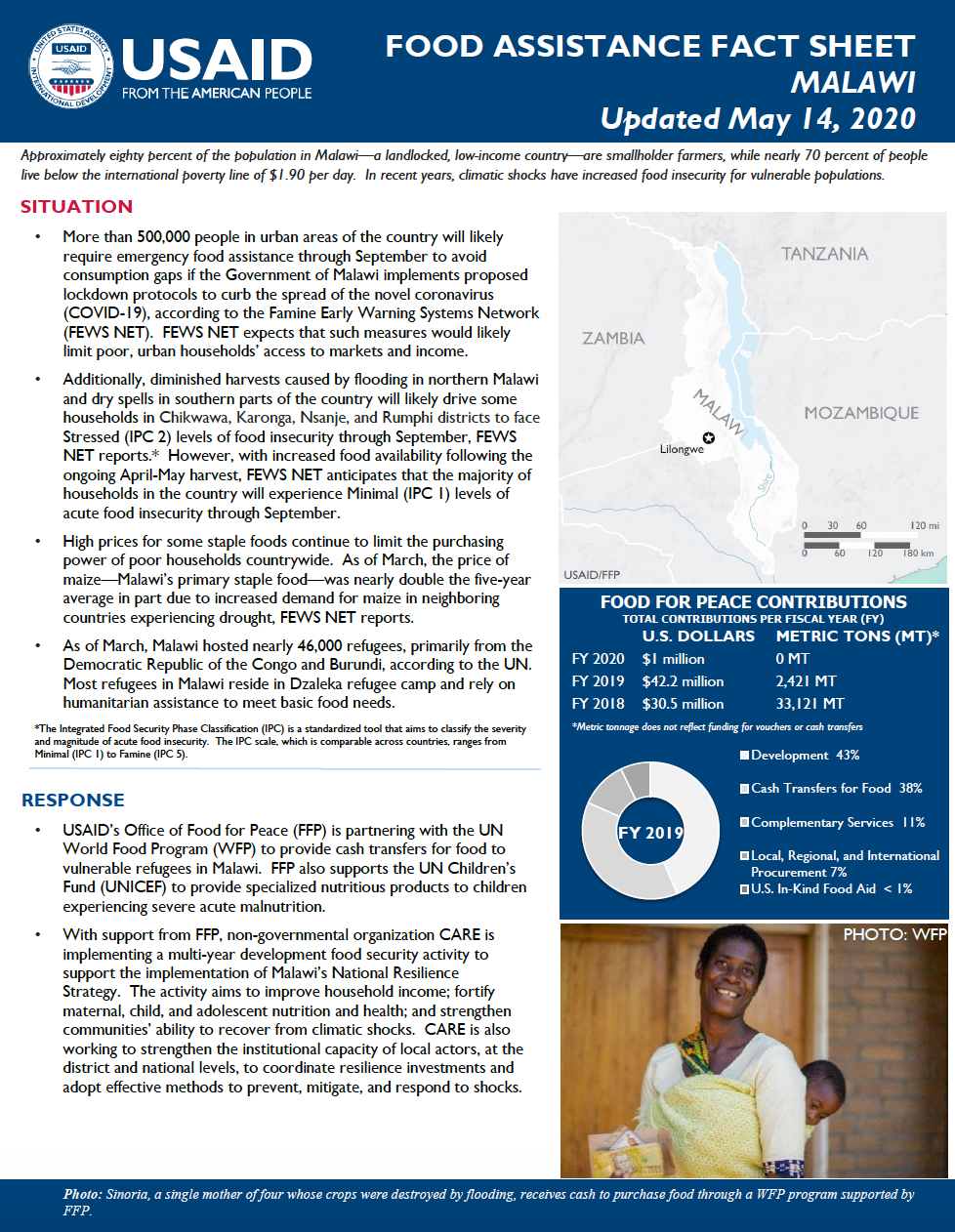Speeches Shim
Malawi is an extremely poor country, with 41 percent of its population living in poverty, and a low ranking of 173 out of 187 countries in the 2015 UNDP Human Development Index (HDI). More than 80 percent of Malawians live in rural areas and depend largely on rain-fed agriculture, which is highly vulnerable to recurrent drought, climatic variation, and natural disasters.
Consequently, Malawi periodically experiences major reductions in food production and the situation is exacerbated by an unfavorable policy environment, low investment in agriculture, and lack of agriculture diversification.
In 2016/17 farming season, the Fall Armyworm emerged in Malawi causing damage on the crops especially staple maize. The result is food and livelihood insecurity for millions of Malawians, and an increased reliance on humanitarian assistance, especially in Central and Southern Malawi.
Food for Peace Development Food Assistance Programs (DFAPs): Beginning in September 2014, USAID’s Food for Peace Program funded two five-year development programs in Southern Malawi, aimed at improving food security and building resilience of over 310,000 vulnerable households.
These programs are: United in Building and Advancing Life Expectations (UBALE), implemented by Catholic Relief Services (CRS) in Blantyre Rural, Chikwawa, and Nsanje districts; and, Pathways to Sustainable Food Security (Njira), implemented by Project Concern International (PCI) in Balaka and Machinga districts.
Both activities focus on: 1) increasing access to and availability of diverse and nutritious foods; 2) improving the health and nutrition of pregnant and lactating women and children under five; and, 3) building resilience of vulnerable households.
Integration and close collaboration with USAID’s Feed the Future activities enables UBALE and Njira to reach vulnerable rural populations with improved agricultural technologies and practices that have the potential to increase production, access to markets, and resilience of smallholder farming systems.
These development activities are designed to build resilience of the most vulnerable populations to natural disasters and recipients of humanitarian assistance, with the aim of reducing or eliminating the need for it.
Humanitarian Assistance: USAID/Food for Peace is a major contributor to humanitarian responses in Malawi. USAID contributes in-kind food commodities, as well as cash, for local and regional procurement of food commodities, and the distribution of maize from the Government of Malawi’s Strategic Grain Reserves to food insecure populations targeted for assistance.
Through the World Food Program, USAID supports a Food for Assets program which targets vulnerable community members with food commodities needed to improve their food and nutritional security in exchange for labor on community work projects such as afforestation/reforestation, watershed management, and small-scale irrigation.
USAID also supports severely acute malnourished children with ready-to-use therapeutic food (RUTF) through United Nations Children's Emergency Fund (UNICEF). The Office of U.S. Foreign Disaster Assistance (OFDA) supports with resources for early agricultural recovery among populations affected by pests, diseases, droughts and floods.
Situation

Malawi is a landlocked, low-income country with over 80 percent of the population consisting of smallholder farmers and nearly 70 percent of people living below the international poverty line, according to the World Bank. Malawi also hosts more than 37,000 refugees, primarily from the Democratic Republic of the Congo, Burundi, Rwanda and Mozambique, the majority of whom are dependent on humanitarian assistance to meet their daily food needs.
According to the Famine Early Warning Systems Network (FEWS NET) (link is external), the majority of the country will face Minimal (IPC 1)* food insecurity; however, FEWS NET anticipates poor households will likely experience Stressed (IPC 2) levels of food insecurity between August and September 2018 in central and southern areas affected by prolonged dry spells and pest infestations. During October to January—when foodsupply levels are typically at their lowest and food prices at their highest—FEWS NET anticipates that poor households in parts of the central and southern regions will face Stressed (IPC 2) and Crisis (IPC 3) levels of acute food insecurity as they deplete their food stocks and rely on market purchases for consumption.
*The Integrated Food Security Phase Classification (IPC) is a standardized tool that aims to classify the severity and magnitude of food insecurity. The IPC scale, which is comparable across countries, ranges from Minimal (IPC 1) to Famine (IPC 5).
Food Assistance Projects
Food Assistance Fact Sheet - Malawi ![]() (pdf - 309k)
(pdf - 309k)
In Fiscal Year (FY) 2017, the USAID Office of Food for Peace (FFP) enabled the UN World Food Program (WFP) to distribute life-saving food assistance through general food distributions sourced from local and regional markets to over 5.1 million food-insecure people. In partnership with FFP, WFP also conducted food-for-asset activities to help over 460,000 smallholder farmers and their communities build resilience and recover from the El Niño-induced drought. In addition, FFP assisted WFP with the procurement, transportation and distribution of maize provided by the Government of Malawi.
Through its partnership with Catholic Relief Services (CRS), FFP is providing longer-term development programming for nearly 248,000 food insecure households to reduce chronic malnutrition and food insecurity and build resilience in Chikwawa, Nsanje, and rural Blantyre — three of the most food-insecure, chronically malnourished and disaster-prone districts of southern Malawi. Furthermore, the FFP partnership with CRS supports the Feed the Future initiative to help smallholder farmers improve their productivity and income in coordination with the Government of Malawi.
FFP also partners with Project Concern International (PCI) to improve food security among 63,400 vulnerable households in Balaka and Machinga districts through a longer-term development project. PCI’s Njira project focuses on supporting market-oriented agricultural production, improving the health and nutrition of children under 5 years of age and pregnant and lactating women, strengthening community disaster preparedness and increasing the resilience of vulnerable households.
Additionally, FFP is partnering with the UN Development Program (UNDP) to evaluate the effectiveness, appropriateness, impact and sustainability of humanitarian response and resilience building in Malawi.
Food for Peace Contributions
Total Contributions:
| U.S. Dollars | Metric Tons | |
|---|---|---|
| Fiscal Year 2018 | $19.9 million | 5,102 MT |
| Fiscal Year 2017 | $63.6 million | 53,211 MT |
| Fiscal Year 2016 | $116.4 million | 83,259 MT |



Comment
Make a general inquiry or suggest an improvement.